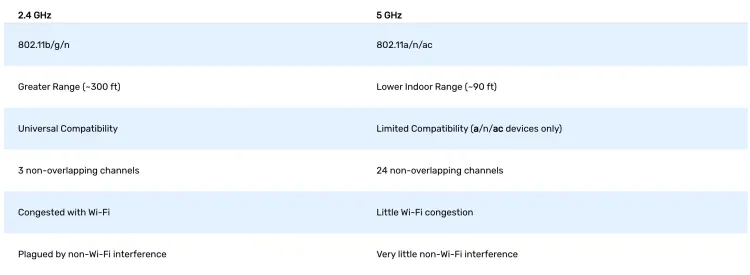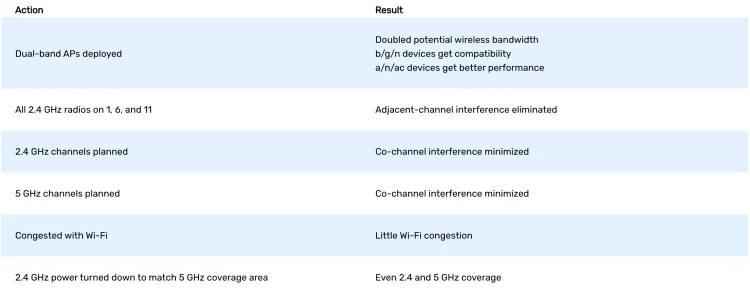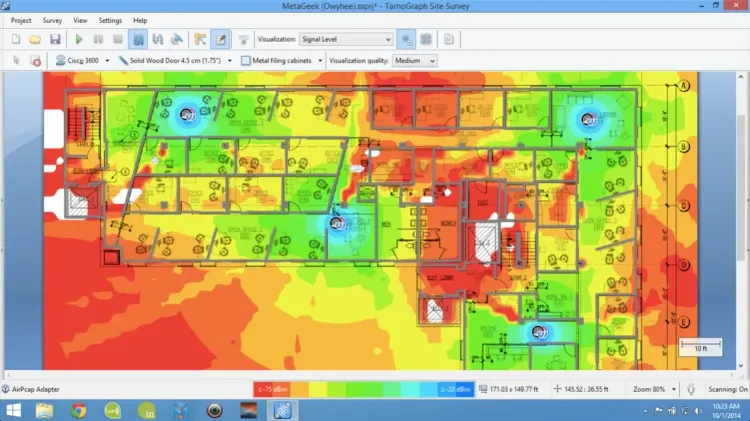Designing Dual-Band Wi-Fi
Understand the trade-offs that each Wi-Fi band has to offer, in order to ensure the best deployment for your site.
No related resources available
Related Advanced Wi-Fi Resources
No related resources available
Design for Both Capacity and Coverage
Needs for wireless networks are growing. Previously, we were able to design wireless networks to simply provide coverage for the desired coverage area. Now, with the demands placed on our networks, we need to design for network capacity, not just coverage. By correctly utilizing both the 2.4 and 5 GHz bands, we can:
Double the potential available wireless bandwidth.
Maintain 802.11b/g/n compatibility for older 2.4 GHz devices.
Provide better performance for newer 802.11a/n/ac compatible devices.
2.4 and 5 GHz Comparison

2.4 GHz has three non-overlapping channels to work with, while 5 GHz has 24. We don't always get to use all of the 5 GHz channels, but overall it offers a lot more space.

Channel Capacity
Many of us are familiar with an ethernet cable, which has multiple twisted pairs of copper wires in one cable. This allows for bi-directional or full-duplex communication. Network devices on either end of the cable can talk at the same time, much like a two-lane highway.
Only One Device at a Time
Wi-Fi is half-duplex, which means that on any channel, only one device can talk at a time. If two devices try to talk at the same time, they would interrupt each other. Wi-Fi is more like a one-lane highway; traffic can only flow in one direction at a time.

Since Wi-Fi is half-duplex, only one Wi-Fi device can transmit on a channel at a time. The more Wi-Fi devices we add to a channel, the more we reduce opportunities for each device to talk. This is known as co-channel interference.
Since only one device can talk on a channel at a time, we need to limit the amount of devices on each channel. By ensuring our channel isn't too crowded, we can reduce co-channel interference.

Devices transmit data at different data rates depending on how new they are (N devices can talk faster than B devices, for example), how close they are to the access point, and how noisy the RF environment is.
Slow devices take longer the transmit the same amount of data. We need to keep our data rates fast to force clients to talk faster and save time, which also reduces co-channel interference.

We can reduce co-channel interference by:
Disabling slower data rates like 1, 2, 5.5, or 11 mbps
Creating smaller coverage cells, so fewer devices share the channel
Creating effective coverage cells where devices are able to always talk quickly
Offering both 2.4 and 5 GHz support, effectively doubling available throughput
Performing effective channel planning to keep cells from having to take turns
Creating effective coverage cells where devices are able to always talk quickly
Channel Planning
2.4 GHz
To eliminate adjacent-channel (also called cross-channel) interference, we only use channels 1, 6, and 11 (1, 5, 9, and 13 in some parts of the world).
To minimize co-channel interference, same-channel access points will be placed as far away from each other as possible. This divides the coverage area into smaller cells. Each small cell has only a few clients, and same-channel cells won't have to take turns with other cells.

Same-channel cells are as far away from each other as possible.
5 GHz
In the 5 GHz band, no 20 MHz channels partially overlap. In addition to this, there are 24 non-overlapping channels to work with, so making sure no same-channel cells touch is much easier.

With 24 non-overlapping channels to choose from, it is much easier to keep same-channel cells touching.
Dual-Band Network Design Checklist

Designing and maintaining a dual-band wireless network requires a good toolset. Fortunately, there are many different types of tools from which you can choose.
Site Survey/Virtual Site Planning Tool
A Site Survey tool allows you to upload a floor plan of a building, and walk through the building to perform a survey. The result is a map of coverage or "heatmap," allowing you to view network coverage and cell overlap. Site survey tools are generally used for post-installation network validation.
A Virtual Site Planning Tool (usually built into a site survey tool) allows you to draw wall types on a floor plan image and place virtual access points. The tool will then calculate approximate coverage in the building. Site planning tools are used for network planning, before the hardware is deployed.

TamoGraph Site Survey in RF Design mode, showing coverage in the MetaGeek office.
Spectrum Analyzer
A spectrum analyzer, like Wi-Spy, is a special piece of hardware that can visualize raw radio frequency activity. While commonly used to detect non-Wi-Fi devices that might cause interference, a spectrum analyzer is also great for viewing channel utilization to see how busy a channel is.
Packet Analyzer
A packet analyzer, like Eye P.A., captures packets on a channel, and gives a detailed breakdown about who was talking fast and who was talking slow. With a packet analyzer like Eye P.A., you get all the details you could ever need to detect co-channel interference.

Subscribe for Updates
Enter your email to subscribe to our newsletter and receive updates.
